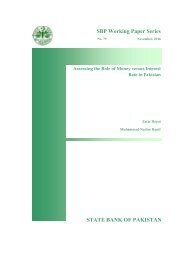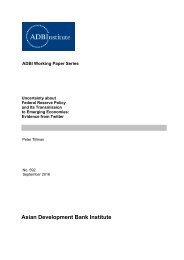SBP Working Paper Series STATE BANK OF PAKISTAN
n?u=RePEc:sbp:wpaper:74&r=mon
n?u=RePEc:sbp:wpaper:74&r=mon
Create successful ePaper yourself
Turn your PDF publications into a flip-book with our unique Google optimized e-Paper software.
frequency (Figure 4, row 4). However, LSM shows considerable negative co-movement with nominal<br />
interest rate at annual frequency (Figure 3, row 4). But these correlations are statistically insignificant<br />
(Table A1). These observations lead us to conclude that nominal interest rate fluctuations have little<br />
contemporaneous impact on fluctuations in real economic activity.<br />
However, this is not the case with real interest rates. The various indicators of real interest rates show<br />
negative co-movement with both GDP and LSM at both annual and quarterly frequencies. In addition, the<br />
contemporaneous correlations in Table A1 show that correlations between GDP and LSM and, the three<br />
indicators of real interest rates are negative.<br />
An important point to note here is that the correlations between LSM and real interest rates are<br />
statistically significant and stronger than the correlations between GDP and real interest rates. This<br />
finding is consistent with the trend of higher than propotional share of the manufacturing sector in bank<br />
credit compared to agriculture and services sector in Pakistan. This finding points towards the fact that<br />
manufacturing sector is more responsive to interest rate based monetary policy as compared to the rest of<br />
the economy.<br />
The dynamic correlation plots (middle panel of Figure 7A & Figure 7B) reflect very weak correlations<br />
between lags of nominal interest rates and GDP. However, strong positive correlations between nominal<br />
interest rates and GDP are clearly visible at lead periods. This hints at a phenomenon where short term<br />
nominal interest rate fluctuations are lagging instead of leading fluctuations in GDP. These dynamic<br />
correlations seem stable over the sample period as neither the signs nor the magnitudes show any<br />
considerable difference over the two sample periods defined in Figures 7A and 7B.<br />
The Granger causality tests confirm this point of view. The Granger causality tests using quarterly data in<br />
Table A3 reports that none of the nominal interest rates Granger causes GDP yet all of them are Granger<br />
caused by GDP. However, annual data shows bidirectional causality between interest rates and GDP.<br />
2.4 Interest Rates and Inflation<br />
The different indicators of nominal interest rates show slightly positive contemporaneous co-movement<br />
with inflation at both annual and quarterly frequencies (Figure 5 & 6, row 4). Table A1 shows that these<br />
positive contemporaneous correlations are statistically significant for six month T-bill rate and money<br />
market rate.<br />
Unlike the contemporaneous correlations, dynamic correlations show a negative association between<br />
lagged interest rate and inflation (Figure 7C, middle panel). However, these correlations are very weak;<br />
not less than -0.1 for all indicators of nominal interest rate. The lead periods of nominal interest rates and<br />
inflation depict positive correlation that is suggestive of validity of Fisher Effect 9 in Pakistan.<br />
Comparison of these dynamic correlations over the two sample windows points out that these<br />
relationships are stable over time (middle panel, Figure 7C)<br />
The real interest rates are uncorrelated with inflation at annual frequency and strongly negatively<br />
9 According to the Fisher Effect, there is a one-to-one correspondence between expected inflation and nominal<br />
interest rate i.e.<br />
9






